 The Journal
of the British Astronomical Association
The Journal
of the British Astronomical Association
Volume 121, No.3: 2011 June
 Summary
contents page
Summary
contents page
Detailed contents: Notes and News / Articles / Observers' Forum /
Reviews / Letters / Meetings / BAA Update
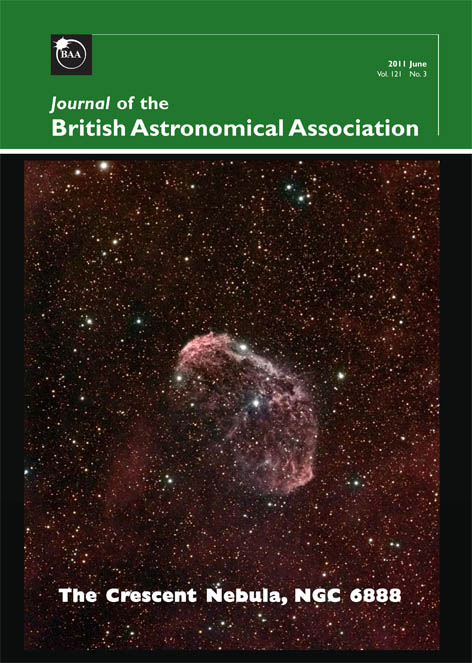

Cover image
Peter Carson imaged the Crescent
Nebula, NGC 6888, using a Tele Vue NP101 f/5.4 refractor. The image is
a combination of 80min H-alpha obtained from his home observatory in
Leigh-on-Sea, Essex and 30min each RGB from Kelling Heath, Norfolk. See
article on p.174.
From the President (David Boyd)
/ ‘Back to Basics’ in Macclesfield: a huge success! (Tony Morris)
/ Aurora Section (Ken Kennedy) / Observations of
supernova 2011B in NGC 2655 (Guy M.
Hurst) / More supernova discoveries for BAA members (Stewart L. Moore) / Solar Section (Lyn Smith) / The BAA
archives – an appeal for original material (Dick Chambers)
/ The Radio Astronomy Group in 2010 (John Cook)
Refereed
papers
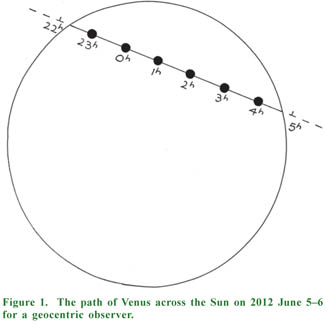
The transit of
Venus, 2012 June 5–6 ... Peter Macdonald
On
2012 June 5–6 there occurs a transit of Venus across the face of the
Sun, the second in the current pair of transits, with just the egress
being visible from the British Isles. The transit occurs at Venus’
descending node with the planet crossing the northern part of the Sun’s
photosphere. For a geocentric observer ingress occurs on June 5 at 22h
10m UT (= Universal Time, which is used throughout this paper) and
egress on June 6 at 04h 50m.
Figure 1 illustrates the path which Venus appears to take across the
Sun for a geocentric observer. In this paper, figures depicting the
solar disk have celestial north at the top and Venus moving from left
to right. The planet appears as a small black disk approximately 1/32
of the Sun’s diameter, and its position is shown at intervals of one
hour.
The
opposition of Mars, 2005: Part I ... Richard McKim
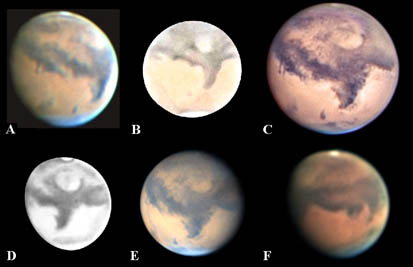 This report
analyses nearly 14,000 observations by 188
contributors during 2004 November to 2006 July. Compared
with its appearance at opposition in 2003, Pandorae Fretum was dark and
complete, as a result of Regional dust activity late in the previous
apparition, whilst E. Deucalionis Regio and Mare Serpentis had returned
to normal. Dust activity was observed around the south polar cap (SPC)
periphery in 2005 July-August, especially in association with the decay
of the SPC outliers Thyles Mons and Novus Mons. A Regional storm
affecting the Hellas-Margaritifer Sinus-Argyre area began about 2005
June 5 (Ls= 225°), and a more significant one began in eastern
Valles Marineris on October 17 (Ls= 308°) with independent bursts
of activity over Solis Lacus and Aram. This major event caused only
small-scale albedo changes: it also deposited dust over the SPC summer
remnant. Local post-opposition dust storms were observed in
Chryse-Xanthe, Aetheria, NE Arabia and NE Tempe-Mare Acidalium. As in
2003, but in contrast to 2001 and 2007, there was no planet-encircling
storm during 2005. An ‘opposition brightening’ was observed upon the
slopes of Olympus Mons, the Tharsis Montes and Elysium Mons. Part II
will discuss white clouds and polar region phenomena.
This report
analyses nearly 14,000 observations by 188
contributors during 2004 November to 2006 July. Compared
with its appearance at opposition in 2003, Pandorae Fretum was dark and
complete, as a result of Regional dust activity late in the previous
apparition, whilst E. Deucalionis Regio and Mare Serpentis had returned
to normal. Dust activity was observed around the south polar cap (SPC)
periphery in 2005 July-August, especially in association with the decay
of the SPC outliers Thyles Mons and Novus Mons. A Regional storm
affecting the Hellas-Margaritifer Sinus-Argyre area began about 2005
June 5 (Ls= 225°), and a more significant one began in eastern
Valles Marineris on October 17 (Ls= 308°) with independent bursts
of activity over Solis Lacus and Aram. This major event caused only
small-scale albedo changes: it also deposited dust over the SPC summer
remnant. Local post-opposition dust storms were observed in
Chryse-Xanthe, Aetheria, NE Arabia and NE Tempe-Mare Acidalium. As in
2003, but in contrast to 2001 and 2007, there was no planet-encircling
storm during 2005. An ‘opposition brightening’ was observed upon the
slopes of Olympus Mons, the Tharsis Montes and Elysium Mons. Part II
will discuss white clouds and polar region phenomena.
Discovery and outburst characteristics
of the dwarf nova
ASAS J224349+0809.5 ... Jeremy Shears et al.
We
report the discovery of a new dwarf nova and observations of its first
confirmed superoutburst during 2009 October. The outburst amplitude was
6 magnitudes. The main outburst lasted 17 days and was followed 4 days
later by a remarkable rebrightening. Superhumps were present during the
main outburst, which confirms that it belongs to the SU UMa family.
Analysis of archival data showed that outbursts also occurred in 2005
October, 2006 June and 2007 June. Assuming that the superoutbursts are
periodic, we estimate that the outburst period is around 450 days.
Measuring the white dwarf spin period
of the intermediate polar
1RXS J063631.9+353537... Jeremy Shears & Ian Miller
We
report unfiltered CCD photometry of the intermediate polar 1RXS
J063631.9+353537, from which we determined the white dwarf spin period
as Pspin= 1008.3(5) sec. Such value is consistent with the
longer of two possible values of Pspin previously reported
by other researchers.
The
aurora in the United Kingdom, 1962–2009 ... R. J. Livesey
In 2009 only one
instance of auroral light was reported, a weak apparition in northern
Scotland. This prompted an examination of auroral records in the BAA’s
possession to see how the aurora has behaved over the years.
Click here to
obtain a PDF file of
any of these articles
- AGM & Ordinary
Meeting, 2010 October 27, held at
the RAS meeting room, Burlington House, Piccadilly, London W1
... Hazel McGee
- Ordinary
Meeting, 2010 November 20, held at
the RAS meeting room, Burlington House, Piccadilly, London W1
... David Arditti
Why not join us at a BAA meeting near
you? Meetings are open
to all and you will be made very welcome. Click here for
the latest Meetings Diary
- The speed of the lunar
shadow on Earth during solar eclipses ... Peter Macdonald
- Light pollution:
plus ça change? ... Jeremy
Shears
- Reporting the aurora ... Ron Livesey
- ‘Five spiders in a Newtonian’ ...
Jeremy Tatum
Reviews
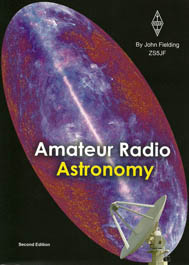
 Amateur
radio astronomy (2nd edn) by
John Fielding
Amateur
radio astronomy (2nd edn) by
John Fielding
Radio Society of Great Britain, 2011. ISBN 978-1-905-08667-2. pp 375,
£16.99 (pbk).
 Reviewed
by Paul Hyde
Reviewed
by Paul Hyde
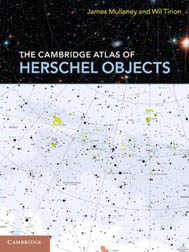

The
Cambridge atlas of Herschel Objects by
James Mullaney & Wil Tirion
Cambridge University Press, 2011. ISBN 978-0-521-13817-8. pp v + 183,
£27.99 (pbk, spiral bound).
 Reviewed
by Stewart Moore
Reviewed
by Stewart Moore
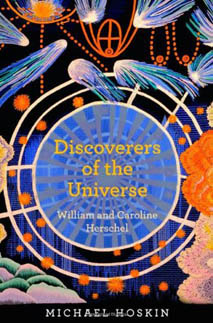

Discoverers
of the Universe: William and Caroline Herschel by
Michael Hoskin
Princeton University Press, 2011. ISBN 978-0-691-14833-5. Pp xvi + 237,
£20.95 (hbk).
 Reviewed
by Jacqueline Mitton
Reviewed
by Jacqueline Mitton
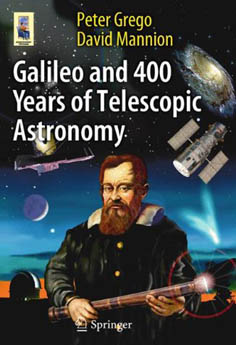

Galileo
and 400 years of telescopic astronomy by
Peter Grego & David Mannion
Springer, 2010. ISBN 978-1-4419-5570-8. Pp. ix + 300, £27.50
(pbk).
 Reviewed
by Mike Frost
Reviewed
by Mike Frost
CLICK HERE
to read scores
more authoritative book reviews from the BAA Journal
Search for all your
leisure needs
at 

BAA Update
Obituary: Andrew John Elliott, 1946-2010 ... Richard
Miles
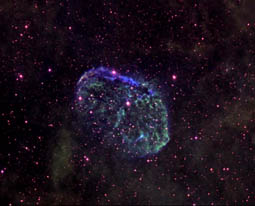
ESOP XXIX, York University, 2010
August 20–24 ... Richard Miles
NGC 6888, the Crescent Nebula ...
Stewart L. Moore
Afterglow of a
gamma-ray burst ... David Boyd
NGC 6888, the Crescent Nebula, imaged by Gordon
Rogers, Long
Crendon,
UK.
 Sky
notes for 2011 June & July by Callum Potter
Sky
notes for 2011 June & July by Callum Potter
Back to top of page
 Go
to the BAA Journal
home page
Go
to the BAA Journal
home page
 The Journal
of the British Astronomical Association
The Journal
of the British Astronomical Association The Journal
of the British Astronomical Association
The Journal
of the British Astronomical Association

 Notes
and News
Notes
and News
 This report
analyses nearly 14,000 observations by 188
contributors during 2004 November to 2006 July. Compared
with its appearance at opposition in 2003, Pandorae Fretum was dark and
complete, as a result of Regional dust activity late in the previous
apparition, whilst E. Deucalionis Regio and Mare Serpentis had returned
to normal. Dust activity was observed around the south polar cap (SPC)
periphery in 2005 July-August, especially in association with the decay
of the SPC outliers Thyles Mons and Novus Mons. A Regional storm
affecting the Hellas-Margaritifer Sinus-Argyre area began about 2005
June 5 (Ls= 225°), and a more significant one began in eastern
Valles Marineris on October 17 (Ls= 308°) with independent bursts
of activity over Solis Lacus and Aram. This major event caused only
small-scale albedo changes: it also deposited dust over the SPC summer
remnant. Local post-opposition dust storms were observed in
Chryse-Xanthe, Aetheria, NE Arabia and NE Tempe-Mare Acidalium. As in
2003, but in contrast to 2001 and 2007, there was no planet-encircling
storm during 2005. An ‘opposition brightening’ was observed upon the
slopes of Olympus Mons, the Tharsis Montes and Elysium Mons. Part II
will discuss white clouds and polar region phenomena.
This report
analyses nearly 14,000 observations by 188
contributors during 2004 November to 2006 July. Compared
with its appearance at opposition in 2003, Pandorae Fretum was dark and
complete, as a result of Regional dust activity late in the previous
apparition, whilst E. Deucalionis Regio and Mare Serpentis had returned
to normal. Dust activity was observed around the south polar cap (SPC)
periphery in 2005 July-August, especially in association with the decay
of the SPC outliers Thyles Mons and Novus Mons. A Regional storm
affecting the Hellas-Margaritifer Sinus-Argyre area began about 2005
June 5 (Ls= 225°), and a more significant one began in eastern
Valles Marineris on October 17 (Ls= 308°) with independent bursts
of activity over Solis Lacus and Aram. This major event caused only
small-scale albedo changes: it also deposited dust over the SPC summer
remnant. Local post-opposition dust storms were observed in
Chryse-Xanthe, Aetheria, NE Arabia and NE Tempe-Mare Acidalium. As in
2003, but in contrast to 2001 and 2007, there was no planet-encircling
storm during 2005. An ‘opposition brightening’ was observed upon the
slopes of Olympus Mons, the Tharsis Montes and Elysium Mons. Part II
will discuss white clouds and polar region phenomena. Meetings
Meetings Letters
Letters
 Reviewed
by Paul Hyde
Reviewed
by Paul Hyde
![]()
 Reviewed
by Stewart Moore
Reviewed
by Stewart Moore
![]()
 Reviewed
by Jacqueline Mitton
Reviewed
by Jacqueline Mitton
![]()
 Reviewed
by Mike Frost
Reviewed
by Mike Frost


 Observers' Forum
Observers' Forum Sky
notes for 2011 June & July by Callum Potter
Sky
notes for 2011 June & July by Callum Potter